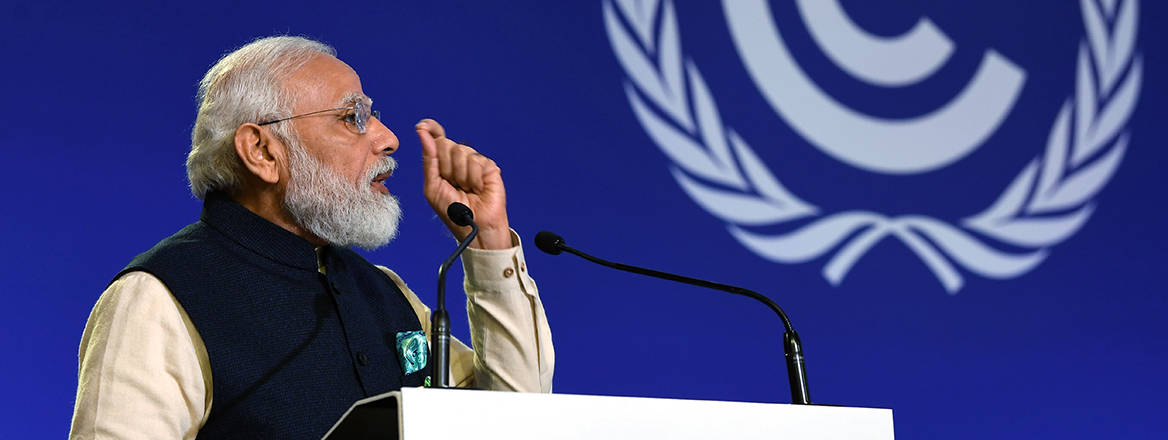RUSI
|
|
India at COP26: Where’s the Roadmap?
Despite the new promises made by India at COP26, doubts remain over the country’s ability to fulfil its obligations on climate change.

India’s Prime Minister Narendra Modi elicited fulsome applause from the more than 100 world leaders gathered at the 26th UN Climate Change Conference of the Parties (COP26) in Glasgow, UK, when he declared that his country would achieve net-zero carbon emissions by 2070.
That the pledged deadline was half a century away was possibly not lost on some in the audience who must have been mindful that they would not be around then – or at least not in power – to seek accountability if the aspirational goal was missed.
Modi further promised that India would expand its renewable, hydroelectric and nuclear power capacity to 500 GW (gigawatts) by 2030, and meet half its energy requirements from renewable energy (RE) sources by that year. He also committed to reducing the carbon India is projected to emit this decade by one billion tonnes.
These are lofty targets for a country that is the world’s third-biggest emitter of greenhouse gases, with 2.65 GT (gigatons) of CO2 equivalent, after China’s 10.06 GT and the US’s 5.41 GT. Yale and Columbia Universities’ biennial Global Environmental Performance Index 2020 ranked India 168th – down from 141st in 2016 – out of 180 countries. The Index uses 32 performance indicators across 11 issue categories to determine how close countries are to established environmental policy targets.
Modi’s avowals apparently surprised even most government officials back home, coming as they did less than a week after some of India’s top politicians had said they would not set a deadline for when the country might achieve net-zero emissions.
A clear roadmap for realising these aims was neither provided nor sought, with observers attributing the announcement in Glasgow to the prime minister’s customary tendency to play to the gallery and indulge in self-adulation.
Observers attributed the announcement in Glasgow to the prime minister’s customary tendency to play to the gallery and indulge in self-adulation
Considering past performance, India’s energy sector will be hard-pressed to come close to reaching the targets articulated by the prime minister. The country will need to increase its present installed capacities of 108.31 GW of RE and nuclear power almost fivefold to 500 GW over the next nine years, while simultaneously raising the combined installed capacities by over two and a half times – from 388.85 GW to 1,000 GW – considering that 500 GW of RE and nuclear power will be needed to meet 50% of the overall installed capacities by 2030.
The country’s RE capacities have increased by 186% since 2014 when the Modi government came to power, according to figures provided by the Ministry of New and Renewable Energy. Sabyasachi Majumdar of credit rating agency ICRA Limited says the increase in RE capacities alone will entail investments of more than $300 billion, apart from additional investments in augmenting evacuation infrastructure and building storage capabilities.
India moreover refrained from signing up to two major initiatives that were ratified by over 100 countries, namely the Global Methane Pledge and the Glasgow Leaders’ Declaration on Forest and Land Use, an initiative to stop deforestation.
Methane is a touchy subject for largely agrarian India, as this greenhouse gas which contributes to raising global temperatures is a byproduct of agriculture, livestock and biomass.
Current highly unsustainable intensive farming practices contribute hugely to climate change, while sustainable regenerative agriculture can be a credible solution, considering its mitigation potential through carbon capture and storage. The latest Special Report on Climate Change and Land of the Intergovernmental Panel on Climate Change holds agriculture, forestry and land use responsible for around one-third of global emissions.
While Modi told world leaders at COP26 that India was the only country delivering in ‘letter and spirit’ its commitments on tackling climate change under the 2015 Paris Agreement, his government appears to be scripting a revolt against the environment back home. Those affected see a planned anarchy that has been unprecedented in scope and which has been sparking humanitarian crises across the land.
While Modi told world leaders that India was the only country delivering in ‘letter and spirit’ its commitments under the Paris Agreement, his government appears to be scripting a revolt against the environment back home
Indian farmers have for the past year been campaigning against three contentious farm laws enacted in September 2020 that are anticipated to transform India’s traditional farming sector into corporate and industrial agriculture, instead of sustainable farming, thereby threatening the country’s food security. Modi has called the laws a ‘watershed moment’ for Indian agriculture and contends that they will increase farmer income, but the protesters are demanding their repeal as they view them as unfair and exploitative, and fear that they will be left at the mercy of big corporates.
Though farmers’ unions estimate that 537 protesters died in the protests up until July 2021 – either through suicide, police excesses or the bitter winter cold – Minister of Agriculture and Farmers’ Welfare Narendra Singh Tomar informed Parliament that month that the government had no record of such deaths.
Similar resistance is building against the Modi government’s move to amend the Forest Conservation Act 1980. ‘It [the amendments] offers full relaxation to businesses like safaris, zoos, linear projects, mining and other non-forest use on forest land’, notes the authoritative environmental journal DownToEarth. It sees the move as ‘a very conscious larceny’ towards providing ‘ease of doing business’ to crony capitalists by providing exemptions to businesses on the pretext of ‘development’.
Overly obliging officials of Corbett Tiger Reserve (CTR) had 10,000 trees cut down in the idyllic sanctuary in the Himalayan foothills, instead of the 163 trees proposed by the state, for a tiger safari project that Modi had proposed while filming an episode of ‘Man versus Wild’ there for Discovery Channel in 2019. A petition against the tree-felling was filed before the National Tiger Conservation Authority, and questions were raised as to why a tiger safari park was at all required in CTR – which, with 252 tigers at present, has India’s largest tiger population among 50 reserves.
New guidelines issued by the Ministry of Environment, Forests and Climate Change (MoEF&CC) now omit the need for prior official clearance for infrastructure projects, even in Eco-sensitive Zones (ESZs), which are designated buffer areas around reserves. With many nature parks not having notified their ESZs, it is feared that the new order will open the way for activities including construction, development and mining in these vulnerable areas.
The government also informed Parliament recently that India’s forest cover was ‘continuously increasing’ and had reached 24.56% of the geographical area of the country, but Washington-based Global Forest Watch, an online platform that provides data and tools for monitoring forests, reported that nearly 38,500 hectares of tropical forest – or 14% of tree cover – were lost in India in 2019–20 alone. It added that the country had seen a 16% loss in forest cover, with 223,000 hectares of tropical forest being lost to human activities – primarily deforestation – in the last decade.
Climate change is already desertifying India by devastating 30,000 hectares of arable land a year and threatening food security for its large population. A study sponsored by the MoEF&CC found that 96.4 million hectares (mhas) – nearly 30% of India’s land area of 328.72 mhas (3.29 million km²) – had been degraded or faced desertification owing to over-exploitation for cultivation, grazing, water resources and deforestation. Land degradation is broadly defined as loss of agricultural productivity.
The Indian public is affronted by the government's extravagance when it is clear the country needs to raise much of its population out of poverty if it is to achieve its environmental goals
Modi also called for ‘lifestyle changes’ that could go a long way towards tackling climate change, and urged for a ‘Lifestyle for Environment’ to be made a global mission. He was evidently aware that not many knew he had flown to Rome and Glasgow in one of two brand new customised B777-300ER planes purchased from Boeing at a cost of $1.14 billion for his, the president’s and the vice president’s exclusive use, whereas previous Indian governments, like most around the world, requisitioned an aircraft from the country’s flag carrier for VIP air travel. These aircraft have state-of-the-art missile defence systems that are supposed to render them as safe as the US president’s Air Force One B747-200B.
The Indian public is affronted by such extravagance when it is clear the country needs to raise much of its population out of poverty if it is to achieve its environmental goals. The UN Development Programme and the Oxford Poverty and Human Development Initiative estimated that an additional 260 million Indians had fallen into poverty owing to the pandemic. India has the highest number of people in poverty globally – defined as those living on less than $2 a day – and the country has slipped to 101st position in the Global Hunger Index 2021 of 116 countries, down from 94th in 2020 and behind its neighbours of Pakistan, Bangladesh and Nepal. The share of wasting among Indian children also rose to 17.3%.
In the meantime, the yearly allocation for the prime minister’s personal security has been raised by 11%, to $80 million, which covers the upkeep of the elite 3,000-strong Special Protection Group that guards him around the clock. And his desire to shift to a grander setting, with a new lavish house for himself, has led to a complete restructuring of the magnificent parliament building in New Delhi that will cost the national exchequer almost $3 billion.
The world – and the poor and the hungry of India – now keenly await India’s fulfilment of its climate change obligations.
The views expressed in this Commentary are the author’s, and do not represent those of RUSI or any other institution.
Have an idea for a Commentary you’d like to write for us? Send a short pitch to commentaries@rusi.org and we’ll get back to you if it fits into our research interests. Full guidelines for contributors can be found here.
Original article link: https://rusi.org/explore-our-research/publications/commentary/india-cop26-wheres-roadmap


